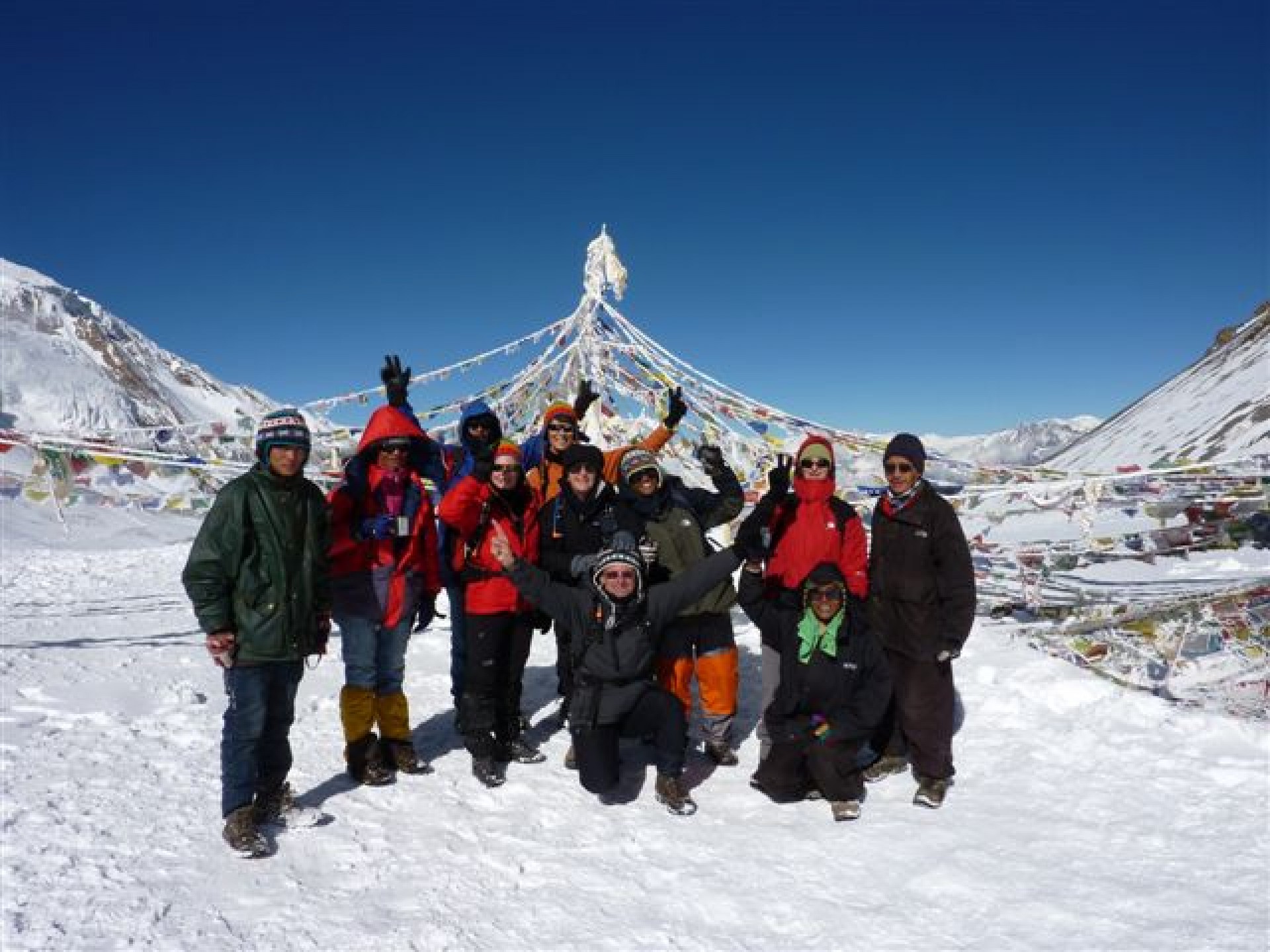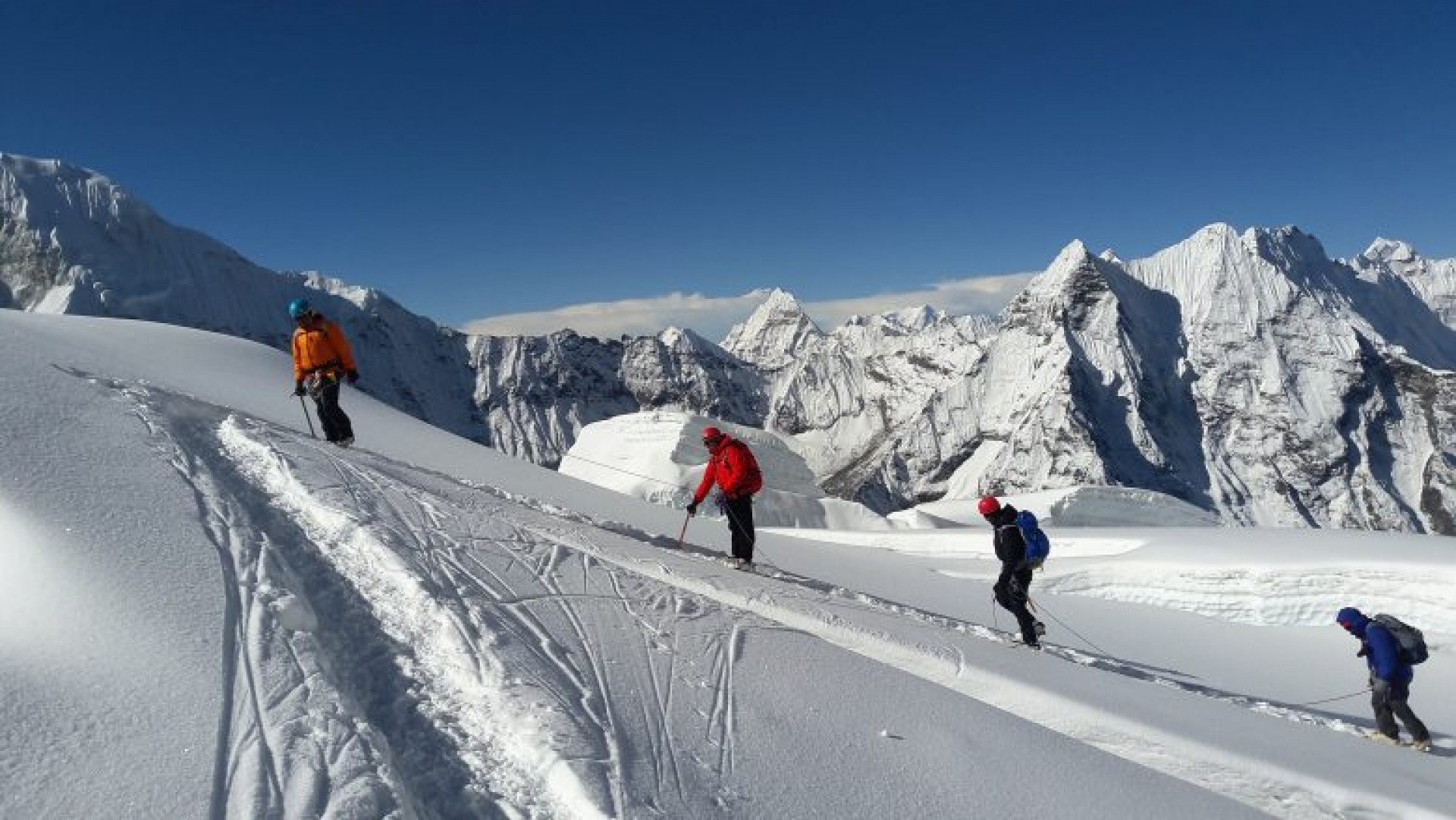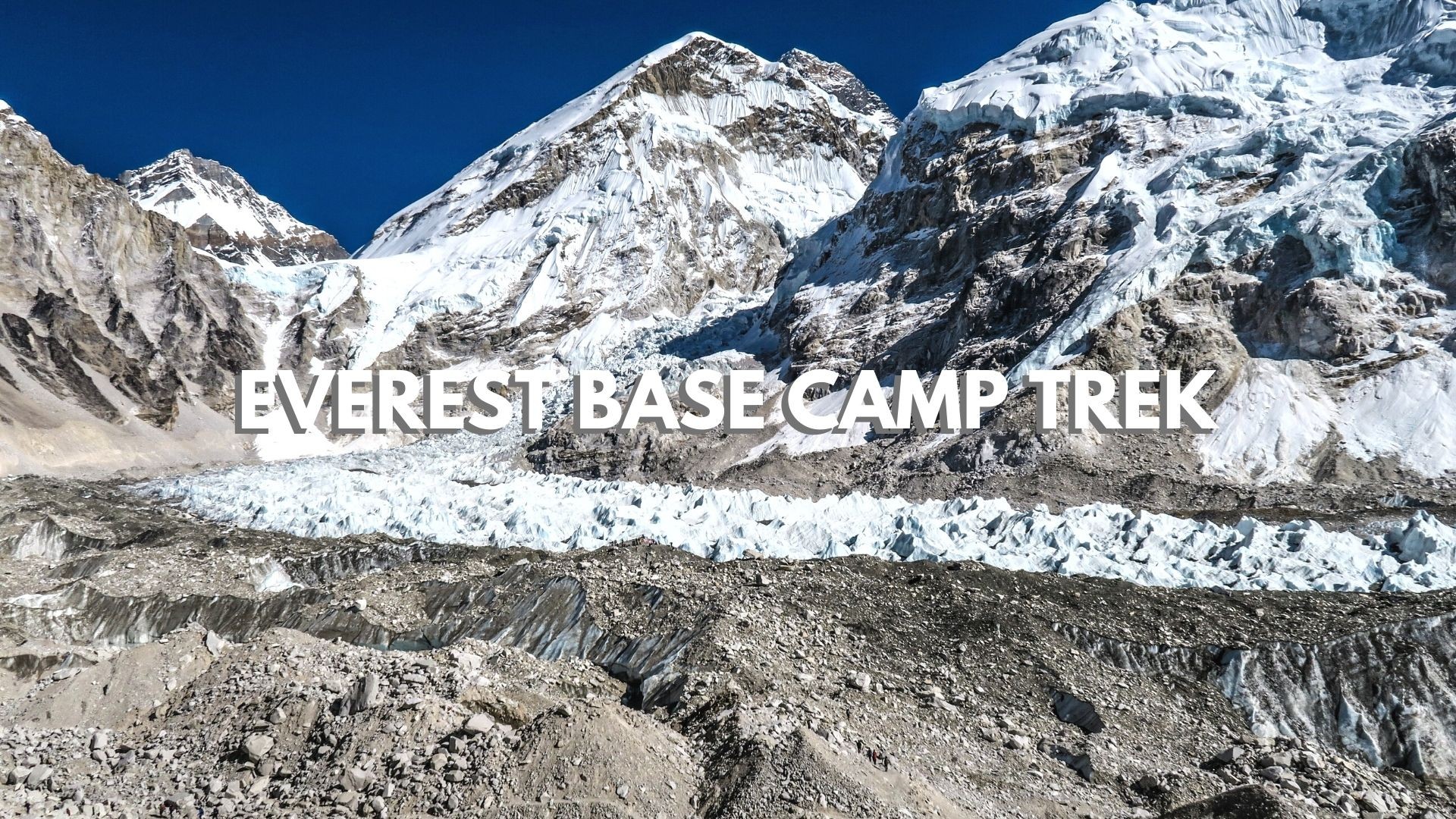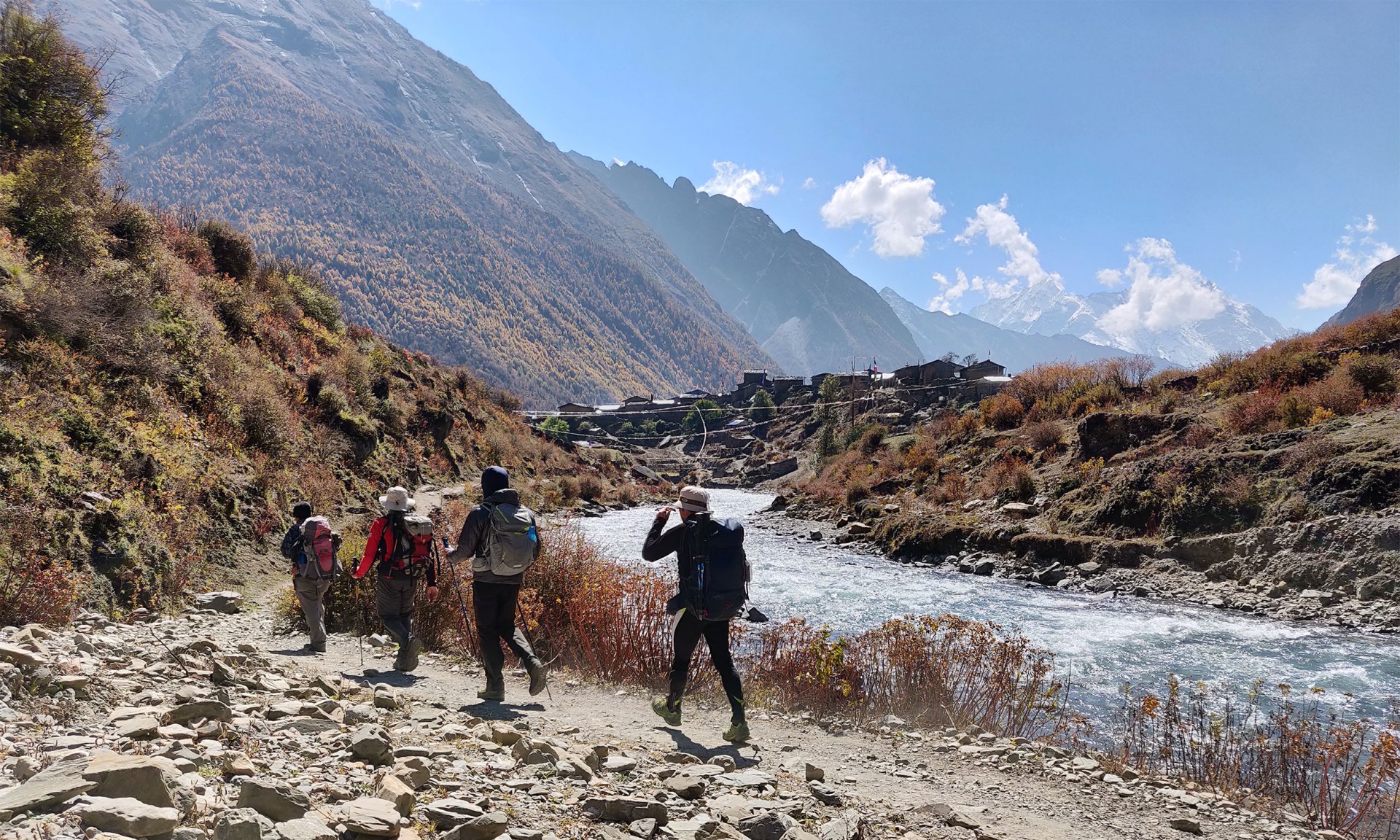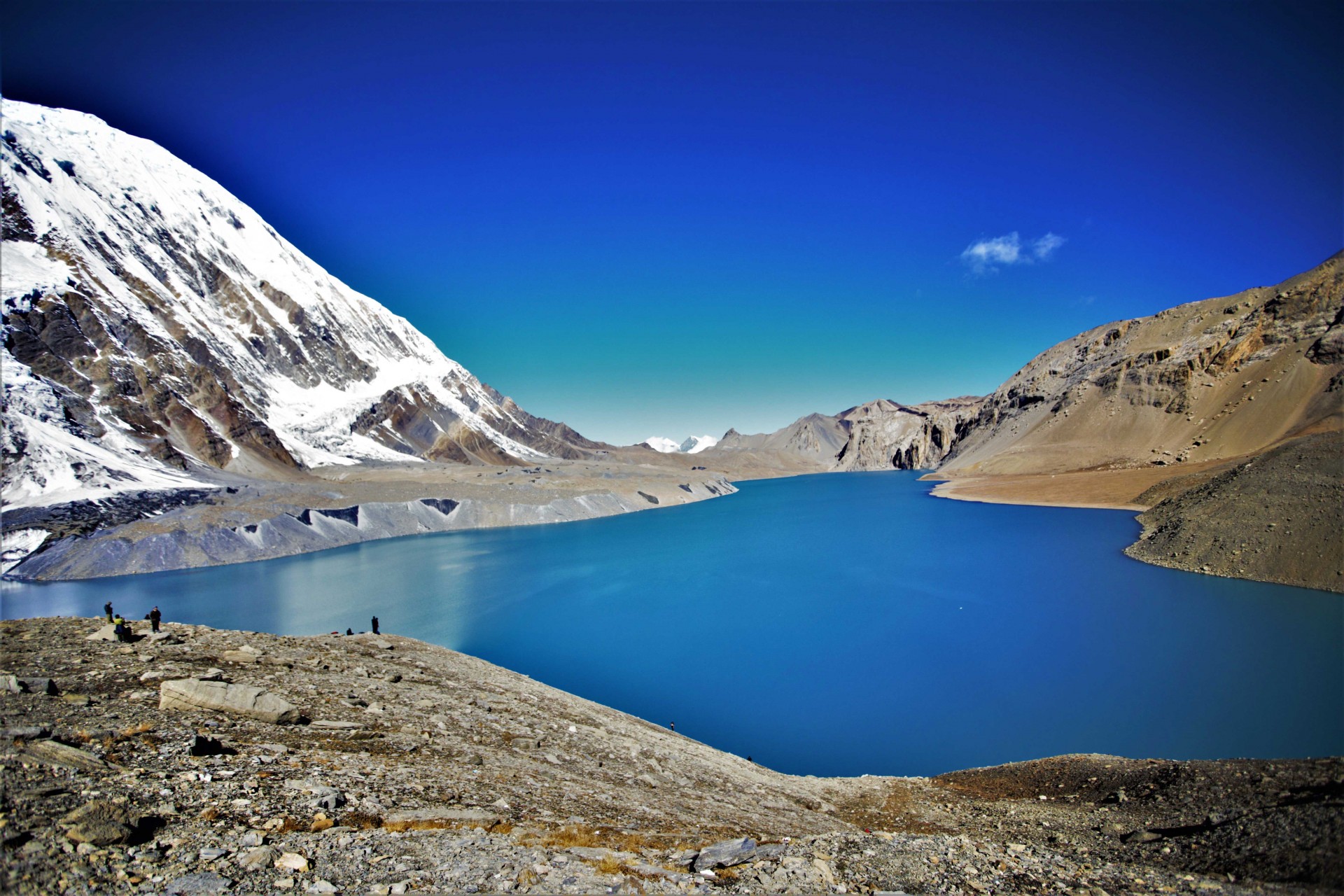Namaste Nepal 13N/14D
Namaste
Joining two hands’ fingers under the nose, bowing his/her head in front of anybody, saying Namaste is the true Welcome and Respect of the Himalayas. This means you are 10 times more important. Nepalese people always use this form to welcome and goodbye somebody as well as in front of temples and monasteries to pray to God, Goddess. This is a form of respect to the elder, unknown, senior people in their daily life.
This package is designed to take you on to complete tour of Nepal in a short period of time. This helps you to unleash the geographic and cultural diversity of Nepal as well as to see and study different aspects of fine arts in its paintings, sculpture, wood carving, and architecture.
Highlights of this tour:
Chitwan National Park (UNESCO World Natural Heritage Site)
It was established in 1973 and listed as UNESCO World Heritage Natural Site in 1984. It covers an area of 932 km2 (360 sq mi). A total of 68 species of mammals, 576 species of birds with 22 globally threatened species as well as critically endangered Bengal Florican, Slender-billed Vulture, White-rumped Vulture, and Red-headed Vulture, 56 species of herpetofauna and 126 species of fish have been recorded in the park. The park is especially renowned for its protection of One Horned Rhinoceros (605), Royal Bengal Tiger (93), and Gharial Crocodile (685).
Birthplace of Gautam Bouddha, Lumbini (UNESCO World Cultural Heritage Site)
The place where, Queen Mayadevi gave birth to Prince Siddhartha Gautam on a full moon day of May in 623 BC, who later through meditation achieved Enlightenment and was renowned as the founder of Buddhism known as Shakyamuni Buddha. A pillar discovered in 1896 from 3rd-century BCE erected by King Ashoka with “Hida Buddha Jadatay” which means this is the place where Buddha was born) provides archeological evidence about Lumbini as a birthplace of Gautam Buddha.
It is separated into two Monastic Zones, Eastern Theravada Monastic Zone and Western Mahayana and Vajrayana Monastic Zone. A sacred Bodhi tree, an ancient bathing pond, the Ashokan Pillar, Mayadevi Temple, along with many monasteries are the major highlights of Lumbini.
Tansen
A beautiful Hill Station in the western part of Nepal, headquarter of Palpa District. It is an ancient trade route with panoramic views of the Himalayas as well as the plains of Terai. Tansen is famous for various kinds of handicrafts, textile, and organic coffee. Karuwa, a water jug made of bronze, typical Nepali cap & shawl made of Dhaka textile are unique souvenirs from Tansen. Tansen is also famous for Ginger. Shreenagar Hill, Rani Mahal on the bank of Kali Gandaki River, old bazaar with typical Newari houses, and paved streets are the major highlights of Tansen.
Pokhara
Pokhara is sub-metropolitan and the second largest city of Nepal. It is regarded as an earthly paradise. It is 627m to 980m above sea level and covers an area of 123 sq. km. surrounded by high mountains. It is also a starting point for the trekkers doing Annapurna Region Trek, Mustang Region Trek, and so on.
Boating in Fewa lake sunrise from Sarangkot hill, Peace Pagoda, Davis fall, paragliding, Zip-line Flyer, Honey hunting, Village tourism with a homestay, white water rafting, caves, Mountains museum, trekking and panoramic views of Himalayan Range (Dhaulagiri, Annapurna, Machhapuchre, and Manaslu) are the major highlights of Pokhara.
Bandipur
Bandipur is a charming hill situated 143 km to the west of Kathmandu and 8 km south of Dumre on the way to Pokhara. It offers magnificent natural views and unique cultural experiences. The majority of the current residents are originally traders from Bhaktapur in the Kathmandu Valley who made their way to Bandipur and settled here. While the Newars are predominant in Bandipur, the Magar and Gurung ethnic groups inhabit the hillsides growing rice, millet, corn, and mustard.
Major attractions while hiking towards Bandipur is the Bindabasini temple, Thani Mai, Tindhara, an evening walk in the Raniban, downhill trek to the recently discovered Siddha cave which is the largest cave in Asia. Magnificent views of the Himalayas like Dhaulagiri, Annapurna, Manaslu, Ganesh Himal, and Langtang Himal introduced Bandipur as a famous hiking site.
Chandragiri Hills
Chandragiri is 15 km away, 30 min drive from Kathmandu, and 11 minutes by cable car. It is 2551 meters above sea level on the south-west of Kathmandu valley. We can admire wide-stretching snow-capped mountains and panoramic view of Kathmandu Valley from Chandragiri. View of Annapurna region to Everest region, green forest, cable car, and view tower, playground for children, Bhaleshwor Mahadev Temple, and a statue of King Prithivi Narayan Shah (18th century King who started the unification of small states into a Nation) are the major attractions of Chandragiri.
Nagarkot
Nagarkot anciently known as Mandapgiri is located 32 km east of Kathamndu 2000 m above sea level. This is one of the famous touristic destinations with a breathtaking panoramic view of snow-capped mountains. 8 Himalayan ranges of Nepal out of 13 can be viewed from here. The ranges include Annapurna Range, Manaslu Range, Ganesh Himal Range, Langtang Range, Jugal Range, Rolwaling Range, Mahalangur Range (Everest Range), and Number Range with views of the Kathmandu valley and Shivapuri National Park.
Bhaktapur Darbar (Palace) Square
Bhaktapur is a city of devotees. During the Lichchhavi period in about the 3rd century, it used to be a prosperous village known by the name of Khowpring or Khowpo or even as Badagaun in Newari Language. The city was originally designed like a conch shell in the 12th century by King Ananda Dev. It lies 13 km east of Kathmandu and 1400 meters above sea level. The lifestyle in Bhaktapur is different than that of Kathmandu with unusual cultural and religious heritage sites. It is known as the cultural capital of Nepal and enlisted in the UNESCO WORLD HERITAGE SITE since 1979. Masterpieces of 17th century Medieval art and architecture are well preserved and renovated exactly as they were.
Highlights:
- Siddhapokhari:(Holy pond constructed by King Yakshya Mall in the 15th century)
- Pottery Square: Experience a traditional way of making household utensils with black clay especially found in Bhaktapur using spinning wooden wheels. We can observe the process of making clay pots in different forms and drying in the pottery square each day.
- Taumadi Square: (18th-century Nyatapol Temple or 5 storey temple is one of the tallest temples in the country which was safe during the great earthquakes in 2015. Goddess Siddhi Laxmi is the main deity enshrined in this temple. Kashi Bairavnath, a 15th-century pagoda-style temple along with Betal Patti and Sattal)
- Darbar Square: (Golden Gate, Statue of Bhupatindra Mall, National Art Gallery, Masterpiece Stone Statue of Ugrachandi, Bairav, Narasingha, Hanumanta Bairav), 55 windows palace, Vatsala Temple, Krishna Temple, Chyasingh Mandap, Taleju Bhavani Temple, Water spout (luhiti), Yakshyashwor Mahadev Temple, etc constructed in the 17th century.
Dattatreya Square
- Bhimsen Temple: The god of power worshipped by the business community was constructed in 1427 AD by King Yakshya Malla and renovated by King Bishow Malla in 1458 AD as well as UNESCO and German collaboration in the early 70s.
- Dattatreya Temple: Pagoda style (Temple of Trinities) Bramha (the creator) Bishnu (the Protector) and Shiva (the destroyer). Datta means to give and Treya means three. Combination of Datta, Som, and Durbasa. This temple is also said to be constructed by a single tree-like Kasthamandap in Kathmandu.
- Pujari Math: 1458 AD by King Bishwa Malla. It was a very powerful Hindu Monastery. It could even punish kings.
- Household products like clay potteries, straw mattresses, clothes like Hakupatasi and Black hats (Bhadgaule Topi), and famous King Curd (Juju Dhau) are other major attractions.
Namobuddha Monastery
Namo Buddha is about 40 km southeast of Kathmandu valley in Kavre District. According to legend, some 6000 years ago, prince Mahasatwo, discovered a tigress about to die starving with her five little babies. Mahasatwo cuts his body and feeds the tigress leaving the bones which were brought back to the village and buried in the tomb. Later in about 3500 years, Gautam Buddha came to the village and declared that he was the reincarnation of prince Mahasatwo. Gautam Buddha renamed this village Namo Buddha, which means Hommage to Buddha.
It is one of the most popular Buddhist destination and a center for tourism. The main festivals celebrated here are Kartik Purnima and Buddha Jayanti. We can see the beautiful panoramic view of snow-capped mountains and landscapes of Panauti and Balthali. This is the holy place where Buddha gave his life to the tigress showing love and compassion to the entire world.
Panuati
Panauti is a small town located 32 km Southeast of Kathmandu. Rosi, Punyamati, and “invisible” river, Lilawati creating a tri-junction (Tribeni Dham) makes it an important pilgrimage site where every 12 years, a month-long fair is held known as the Makar Mela. During this celebration, hundreds and thousands of devotees visit Panauti to cleanse themselves in this sacred water. The Harisiddhi dance is considered to be the oldest traditional dance in Nepal. This dance was initiated about 2,400 years ago by King Vikramaditya. It is said to use the language of gods and speech of the spirits. Pagoda Style three-story Indreshwor Mahadev Temple was restored in Medieval period by different rulers and with French-Aid in 1982-1983 AD, A 16th-century Unmatta Bhairab Temple, Tulanarayan Temple, Sohrakhutte Pati, Lapati, Ghat sattal, Dharmadhatu Chaitya, Umamaheshwor, Stone pillar, Satya Narayan, Laxmi Narayan, Krishana Narayan, Surya Narayan, A 17th-century Brahmayani Temple, and Tin Dhara are the major highlights of Panauti.
UNESCO World Cultural Heritage Site of Bhaktapur, Kathmandu and Patan.
Pashupatinath
Pashupatinath is a famous, sacred Hindu temple dedicated to Lord Shiva and is located on the banks of the Bagmati River 5 kilometers east of Kathmandu Valley. This temple is considered one of the sacred temples of the Hindu faith. This holy place is listed in UNESCO World Heritage Sites since 1979 AD. It was believed to be in existence since 400 B.C. constructed by Lichchhavi King Supuspa Deva mentioned in a stone inscription erected by King Jayadeva 11 in the courtyard of Pashupatinath in 753 AD and being renovated by and modified by different kings. The head priest is Bhattas (Vedic Dravida Brahmin Scholars) appointed by Adi Guru Shankaracharya. Bhandari is the treasurer, temple caretakers, and assistant priest of the temple. A lot of devotees visit Pashupatinath on Monday since it is called the day of worshipping Shiva but people worship Pashupatinath every day. We can see a lot of monkeys on the premises and deer in the deer park. The most important festival is the Maha Shiva Ratri (Great Shiva Night) on the month of February and Teej (Nepalese women fasting festival for the long life of their husband) falls in late August or early September. The major highlights of Pashupatinath are cremations on the bank of Bagmati River performed every day, Deer Park (where Lord Shiva used to be an antelope), Ram Mandir, evening Ganga arati (Three Priests perform this worshipping (arati) on the bank of holy Bagmati River taking oil lamps and moving them in a circular motion and dedicating their actions to God. Songs with religious themes are sung by devotees during the spectacular worshipping (Aarati) every evening at 6 pm.), Ananta Narayan, Kali, Dome style Laxmi Narayan Temple, the residence of holy Hindu monks popularly known as Sadhus, School of Vedic rituals and so on.
Boudhanath:
Approximately 6-7 km northeast of the center of Kathmandu, Boudhanath Stupa is commonly known as Boudha or Boudhanath (Lord of Wisdom). This is the largest Stupa in the world with 120 ft in diameter, 1 hector in width, and 43.25 m in height with an area of approximately 6,756 sq meters. Many people believe that Bouddhanath was constructed in the 4th century by king Mandeva right after the death of Buddha. The Stupa is said to entomb the remains (Astidhatu) of a Kashyapa Buddha. Now we do have around 50 monasteries around the Boudhanath area.
We can buy colorful Thankas, Tibetan jewelry, hand-woven carpets, masks, and khukuri (knives) in Boudha. Smaller stupas are located at the base. Gompa monasteries, curio shops, and restaurants surround Boudhanath. Restaurants with roof-top provide good food and excellent views of Boudhanath. After the 1950 Chinese invasion of Tibet ten thousand Tibetans settled down here since then the temple has become one of the most important centers of Tibetan Buddhism. Today it remains an important place of pilgrimage and meditation for Tibetan Buddhists and local Nepalis, as well as a popular tourist destination. Losar (Tibetan New Year) and BuddhaJayanti are major festivals celebrated in Boudhanath.
Swyambhunath
lies 3 km west of Kathmandu, Swayambhunath is one of the holiest ancient Buddhist Stupa in Nepal. Swayambhu means “self-existent one”. It was said to be built by King Manadeva in 460 A.D. as per the stone inscription. During the 13th century, Swayambhunath had developed into an important center for Buddhism. It is believed that the Kathmandu valley used to be a huge lake by the name of Nagadaha. Bipashwi Buddha sowed the seed of the Lotus flower that bloomed in the middle of a lake. A lot of devotees come to pay homage to the Holy Lotus. Manjushree (God of knowledge and wisdom) came from China and paid homage to the holy lotus from the place called Nilgiri (which is present-day Nagarkot). He drained the water out of the lake from the place called Chovar. It is believed that he covered the holy lotus with the dome and meditated.
Temple of Harati Ajima, Nagpur, Pratappur, Anantapur, Agnipur, Santipur, Vasupur, Bayupur, Bihars, and Chaityas, prayer flags (representing five cardinal elements of life) are the major highlights of Swayambhu. Swayambhu is perhaps the best place to observe religious harmony between Hinduism and Buddhism in Nepal.
Kathmandu Durbar Square
It is believed that around 2500 years ago Kathmandu valley used to be a great lake. Manjushree a follower of Buddha drained the water out of the valley with his magical sword from the place called Chovar. Kathmandu is also known as Kantipur (City of glory) is said to be designed like Khadga (Sword) by King Gunakamdeva around 725 AD, a devotee of goddess Kali. The name remains up until the 16th century. We will be able to see palaces, temples, stupas, and many more during our visit. The temple of Mahendrashwor Mahadev 1562 AD, and Taleju Bhavani Temple 1564 AD by King Mahendra Malla, the stone inscription of different languages, a statue of Hanuman (monkey god) in front of Palace, Basantapur Durbar ( nine-story palace) constructed by King Prithivi Narayan Shah after the unification of small states into a greater Nepal in the year 1770, Jaganath Temple with erotic carvings, also known as love temple, Big Bell 1797 by King Rana Bahadur Shah, a statue of KalBhairav found in Nagarjun forest in the 16th century, White Bhairava opens only during the festival of Dashain, Shiva Parvati Temple by Rana Bahadur Shah, Gaddi Baithak 1908 AD, Kumari Ghar dedicated to the living goddess Kumari 1757 AD said to the incarnation of Taleju Bhavani Royal deity of Malla kings by King Jaya Prakash Malla, 12th-century Kasthamandap also known as Maru Sattal said to be built by a single tree, and Freak street or hippie street are major highlights of Kathmandu Durbar Square.
Patan Darbar (Palace) Square
The official name of the city is “Lalitpur” (City of Beauty). It is located about 5 km south of Kathmandu. Patan is one of the medieval royal cities in the valley. We can see beautiful wood and stone carvings, metal statues, ornate architecture, including dozens of Buddhist and Hindu temples in Patan. The city is known for its rich tradition of arts and handicrafts and as the birthplace of master craftsmen and artist Araniko. It is believed to be designed in the third century B.C. by the Kirat dynasty and expanded by Lichhavis in the 6th century A.D. and again by the Mallas in the medieval period. The Malla kings ruled the Kathmandu Valley until the unification of small states into a great nation by King Prithvi Narayan Shah in 1768.
The Golden Temple (Hiranya Varna Mahavihar):
The Golden Temple (Hiranya Varna Mahavihar), built in the 12th century by King Bhaskar Verma located just north of Durbar Square, Machhindranath Temple, Rudra Varna Mahavihar (Buddhist monastery), Kumbheshwor Temple oldest 5 storey temple in Nepal built by Jayasthiti Malla in 1391 AD, 17th century Krishna Mandir by King Siddhi Narashing Malla, Four Ashok Stupas said to be constructed by King Ashoka in 250 BC in four corners of the city (Pulchwok, Lagankhel, Ebahi (on the way to Sankhamul) and Teta (on the way to Lubu Sano Goan)), 14th-century Mahabouddha (1000 statues of Buddha in every single brick) by Avay Raj 1564 AD in his own property, 6th-century Accheshwor Bihar are some of the major highlights of Patan.
DETAIL ITINERARY:
Day 01: Arrival In Kathmandu (1350m) And Transfer To Hotel 45min. O/N Hotel (D). +−Our guide will be waiting you at TIA, welcome you with the garland of flowers and transfer to Hotel Sangrila. According to your arrival time, we check in Hotel and little rest, our guide take you to visit busy nepali market called Asan Tole, Indrachok. This is the famous and old Nepali market where they buy everything they need in their daily life. We can also see several Pagoda Temples through this visit. Then our guide hire some Rickshow (three wheels cycle) to take you through Thamel (First touristic city of Nepal) where we see many shops, restaurants, hotels, to our Hotel. Dinner at Hotel Sangrila.
Transfer : 40 mins
Visiting Time : 2 hours
Dinner and O/N : Hotel Sangrilla
After hot breakfast in the morning, at around 8:00AM we drive to Chitwan (4 to 5 hours) or take a flight to Bharatpur (20 mins) then drive to Green Mansion Resort, welcome drink, briefing about program, lunch, cultural tour to Tharu Village, museum Tour, sunset view and dinner.
Transfer : 5 hours
Lunch : Chitwan
Dinner and O/N : Green Mansion Resort
Wake up call, breakfast, canoeing, nature walk, elephant breeding center visit, elephant bathing, lunch, elephant back safari, Tharu stick dance and dinner.
Wake up call, breakfast, bird watching and departure to Lumbini. Drive 4h30mins to Lumbini. Birth place of Lord Bouddha, in the full moon day of May 623 BC, Maya Devi gave birth to the Crown Prince Siddhartha, took his first seven steps and uttered an epoch-making message to the suffering humanity. Lunch at Hotel Nirvana or Buddha Garden. In the afternoon, we visit Lumbini Garden. Back to Hotel.
Transfer : 4h30m
Lunch : Buddha Garden Hotel
Visiting Time : 2 hours
Dinner and O/N : Buddha Garden Hotel
Today, this whole day is dedicated to unleash Bouddhism and Bouddha. We visit Maya Devi Temple, Monastic Zone both eastern and western. We of course do a half an hour meditation in this holy place. Back to Hotel.
Visiting Time : 4 hours.
Lunch/Dinner/O/N : Same Hotel.
After hot breakfast in the morning, we drive to Tansen, the most popular summer resort with far stretching views of the Himalayas. At an altitude of 1400m, it is an ideal hill station, situated on the southern side of the Mahabharat range in south central Nepal. On arrival, we first proceed for lunch then start our tour. After visiting, drive to Pokhara, a natural diversity with Annapurna range, Machhapuchhre, Himchuli reflects on the Phewa Lake, second largest lake of Nepal.
Transfer : 6 hours
Lunch : Tansen
Dinner and O/N : Hotel Sangrilla Village Resort, Pokhara.
Wake up early in the morning at 5:00am, drive to Sarankot Hill for sunrise view with the snow-capped mountains namely Dhaulagiri, Annapurna South, Hiuchuli, Machhapuchre etc. We will have café or tea in the Sarankot Hill, drive back down to Bindashini Temple. An oldest temple in the Pokhara valley. A hindu goddess temple where if lucky we can see the marriage ceremonies and the beautiful view of mountains and landscapes. Drive to Hotel and breakfast. After breakfast, drive to Davi’s Fall, locally known as Patale Chhango was named Davi’s Fall after a Swiss lady was swept away and died in 31 july 1961. The water flowing from Phewa lake shows a wonderful fall. We find hollow sandy part and a heavy fall of water within its natural trench. Then drive to WORDL PEACE PAGODA, it is a massive Buddhist stupa located on a hill top (Rani Ban) just southern hill of Phewa Lake. This stupa is the symbol of peace where the huge idols of Lord Buddha from Japan, Sri Lanka and Thailand have been installed. From here we can enjoy the breathtaking view of Himalayan ranges, lakes, and the Pokhara Valley. Drive back to Phewa lake for 1 hour boating and visit Tal Barahi Temple, it is located on a small island in the middle of Phewa Lake just offshore from the lakeside. The atmosphere is so tranquil that we can enjoy the green forest scenery just across the south end of the lake, full scale scenery of the lake and amazing reflection of the Annapurna and Fishtail mountains on the surface water of the lake. Free time at lakeside, dinner at Hotel.
Transfer : 2 hours
Lunch : Sangrilla Village Resort
Dinner and O/N: Same Hotel.
After hot breakfast in the morning, little free time then drive to Bandipur. A very beautiful hill station at an altitude of 1030m, where we can see the beautiful newar village. Lunch at Old Inn Bandipur, after lunch drive to Kurintar. We cross the Trisuli River, a well-known rafting river of Nepal by iron bridge. Then we walk about 45mins to reach Summit River Lodge, a very good lodge with Summing Pool. We can enjoy the pool. And One night near the Trisuli River would be your one of the best experience.
Transfer : 3 hours
Walking Time : 45 mins
Lunch : Old INN Hotel, Bandipur
Dinner and O/N : Summit River Lodge
After hot breakfast in the morning we drive to Kathmandu. At entry point Thankot, we take cable car to reach to Chandragiri Hill (2551m) where we take hot lunch. We admire beautiful Kathmandu Valley and landscape with snowcapped mountains. Back to Thankot by cable car and drive to Nagarkot, very famous northern hill station for sunrise and sunset views with breathtaking panoramic views of the Himalayan ranges.
Transfer : 5 hours
Lunch : Chandragiri Hill's restaurant.
Dinner and O/N : Club Himalaya
Wake up early in the morning to admire the red sunrise which hit the snow capped breathtaking Himalayan ranges and it's change their color in gold. And of course landscape of Nagarkot. After Hot Breakfast, drive to Bhaktapur (13km), visit Bhaktapur Darbar Square, Taumadhi Square, Pottery Square, Dattrataya Square, lunch at Bhaktapur, drive to Namobuddha. Dinner and Overnight at Namobuddha Resort.
Transfer : 2h30m
Lunch : Bhaktapur
Dinner and O/N : Namobuddha Resort.
Hot breakfast with the beautiful Himalayan views in Namobuddha Resort. Visit Namobuddha Monastery then drive to Pashupatinath Temple. A very famous and holy hindu temple of Lord Shiva, it is also enlisted in the UNESCO WORLD HERITAGE SITE (CULTURAL) in 1979. On the bank of the holy river Bagmati every day cremation take place. Then it takes only 20 mins drive to reach Bouddhanath Stupa, a biggest stupa of Asia. We take lunch here and drive to Shangrila Hotel.
Transfer : 2h30m
Visiting Time : 2h30m
Lunch : Bouddha
Dinner and O/N : Kathmandu Hotel Sangrilla
After hot and healthy breakfast at Hotel, we drive to visit Soyambhunath Stupa on the top of the Hill. Here we can see magnificent stupa, surrounded by 5th century stone carving Five Bouddha and combination of Hinduism and Buddhism. Then, we drive to visit Kathmandu Darbar (Palace) Square. Finally we drive to visit Patan Darbar (Palace). These all three sites are UNESCO WORLD CULTURAL HERITAGE SITE, enlisted in 1979. In this two historical sites we can see 14th - 18th century Pagoda Temples, Sikhara Temples, Palace, 5 storey temple ........
Back to Hotel.
Transfer : 2h30m
Visiting Time : 5h30m
Lunch : Patan
Dinner and O/N : Kathmandu Sangrilla Hotel.
This is the free day you can shop and visit on your own or as you like. Dinner at Utsav Restaurant, a very well known restaurant for the delicious food with Nepali cultural dance show. Back to Hotel.
Lunch : On your own.
Dinner : Utsav Restaurant
O/N : Same Hotel.
According to your flight time, we drive to Tribhuvan International Airport from Hotel. 35mins.
PACKAGE INCLUDES:
- All the transportation in private air-conditioned vehicle.
- Accomodation in Kathmandu, Chitwan, Lumbini, Pokhara, Riverside, Nagarkot, Namobuddha resort.
- Three times meals (BLD): Breakfast, Lunch and Dinner.
- An experienced English speaking cultural guide and driver.
- All the entrance fees and tickets.
PACKAGE EXCLUDES:
- Medical/Travel Insurance.
- All the personal expenses such as bar bills, all king of beverages, laundry, telephone calls etc.
- Airfaires.
- Visa fees.
- In case of emergency rescue or evacuation expenses such as accidednt, natural disaster etc.
- Tips for guide and driver (Tips are accpeted but not mendatory)
NOTE:
In Kathmandu and Pokhara, there are lots of choice in restaurants like continental, italian, chinese and many more according to your choice and budget to enjoy the delicious foods.
supplimentary room charge is $85.
There is regular flight from Kathmadu - Bharatpur (Chitwan), Kathmandu - Pokhara, and Pokhara - Kathmandu. Domestic Flights are the optional choice but you have to pay the airfaire charge.




